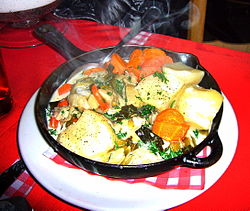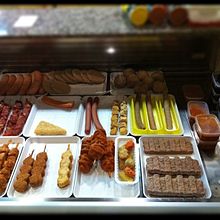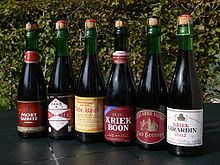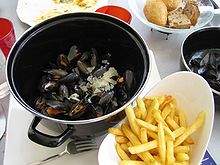- Belgian cuisine
-
Belgium has been called a nation of gourmands rather than gourmets: a country, in other words, where "big cuisine" comes before "fine cuisine". It has been said that Belgium serves food of French quality in German quantities.[1]
Contents
Frieten or frites
 French fries wrapped in a traditional paper cone, served with mayonnaise and curry ketchup, with a small plastic fork on top and a frikandel on the side.
French fries wrapped in a traditional paper cone, served with mayonnaise and curry ketchup, with a small plastic fork on top and a frikandel on the side.
Fries, deep-fried chipped potatos, are very popular in Belgium. In Belgium you can buy fries in special places called "friteries" (Wallonia and Brussels) or "frietkot"/ "fritkot" / "frituur" (Brussels and Flanders). They are served with a large variety of sauces and eaten either on their own or in the company of other snacks as fricandelle or burgers. Traditionally, they are served in a "cornet de frites", a conic white piece of cardboard then wrapped in a piece of paper, with a good spoonful of sauce on the top. With the fries they serve many traditional fastfood products, such as frikandel, gehaktbal or kroket.
Sauces
Friteries and other fast-food establishments tend to offer a number of different sauces for the fries and meats. In addition to ketchup and mayonnaise, it is common to offer many others, with popular options including .[2]
- Aioli, garlic mayonnaise.
- Sauce Andalouse - mayonnaise with tomato paste and peppers.
- Sauce Americaine - mayonnaise with tomato, chervil, onions, capers and celery.
- "Bicky" Dressing (Gele Bicky-sauce), a commercial brand made from mayonnaise, white cabbage, tarragon, cucumber, onion, mustard and dextrose.
- Curry mayonnaise.
- Look-sauce - mayonnaise with garlic.
- Mammoet-sauce - mayonnaise, tomato, oinion, glucose, garlic, soy sauce.
- Sauce "Pickles"- a yellow mayonnaise-based sauce with turmeric, mustard and crunchy vegetable chunks, similar to Piccalilli.
- Samurai-sauce - mayonnaise with sambal oelek.
- Pepper-sauce - mayonnaise with green pepper, garlic, glucose.
- Tartar Sauce.
- Zigeuner sauce — A "gypsy" sauce of tomatoes, paprika and chopped bell peppers, borrowed from Germany.
These sauces are generally also available in supermarkets. Occasionally hot sauces are offered by friteries, including hollandaise sauce, sauce provençale, Béarnaise sauce or even a splash carbonade flamande stew from an ever-bubbling pot, in the spirit of British "Chips and Gravy".
Beer
Main article: Beer in BelgiumAnother Belgian speciality is beer.[1] For a comparatively small country, Belgium produces a very large number of beers in a range of different styles – in fact, it has more distinct types of beer per head than anywhere else in the world. Almost every style of beer has its own particular, uniquely shaped glass or other drinking-vessel.
A number of traditional Belgian dishes use beer as an ingredient. One is Carbonade (French: the Flemish term is stoofvlees or stoverij), a stew of beef cooked in beer, similar to Boeuf bourguignon. The beer used is typically the regional speciality — lambic in Brussels, De Koninck in Antwerp, and so on — so that the taste of the dish varies. Another is rabbit in gueuze. In't Spinnekopke, Brussels, and Den Dyver, Bruges are famed for their beer cookery.
The varied nature of Belgian beers makes it possible to match them against each course of a meal, for instance:
- Wheat beer with seafood or fish.
- Blonde beers or tripel with chicken or white meat
- Dubbel or other dark beers with dark meat
- Fruit lambics with dessert
Chocolate
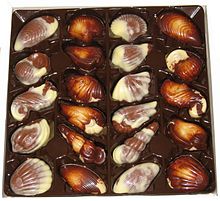 Guylian seashell pralines
Guylian seashell pralines
Belgium is commonly known for its chocolate. Belgian chocolate is considered to be the gourmet standard by which all other chocolate confections are measured. Even the Swiss, known for their own high quality chocolate, imported the basic recipe from French and Belgian chocolatiers. What makes Belgian chocolate unique is the quality of ingredients (many aspects of its composition are regulated by law) and an almost adherence to Old World manufacturing techniques. Even in today's world of automation and mass production, most Belgian chocolate is still made by hand in small shops using original equipment. In fact, these small chocolate outlets are a popular draw for tourists visiting Belgium today.
Seafood pralines are popular with tourists and are sold all over Belgium. Chocolaterie Guylian for instance, makes the pralines according to the recipe from the company’s founding father Guy Foubert who created it in the Sixties. Today the praliné is still made to this same secret recipe, in the age-old traditional manner. This is a clear example that is typical for Belgian Chocolates.
Typical dishes
- Moules-frites or Mosselen-friet: mussels and chips.
- Konijn in geuze/lapin à la gueuze: rabbit in geuze, which is a spontaneously fermented, sour beer from the area around Brussels.
- Stoemp: potato mashed with other vegetables, often served with sausages.
- Salade Liégeoise / Luikse salade: a salad with green beans, pieces of bacon, onions and vinegar, associated with Liège.
- Vlaamse stoofkarbonaden: a Flemish beef stew, similar to the French Beef Bourguignon, but made with beer instead of red wine.
- Waterzooi: a rich stew/soup of chicken (or sometimes fish), vegetables, cream and eggs, associated with Ghent.
- Paling in 't groen/anguilles au vert: Eel in a green sauce of mixed herbs.
- Gegratineerd witloof/chicons au gratin: a gratin of chicory in béchamel sauce with cheese.
- Boterhammen/Tartines: Slices of rustic bread and an uncovered spread, often pâté or soft cheese, served on a board and eaten with knife and fork. A typical variety is a slice of bread with quark and sliced radishes, typically accompanied by a glass of gueuze.
- Tomate-crevette / tomaat-garnaal: a snack or starter of grey shrimp in mayonnaise stuffed into a hollowed-out raw tomato
- Pêches au thon / perziken met tonijn: halved canned or fresh peaches stuffed with a mix of tuna and mayonnaise, i.e. tuna salad
- Pensen or Boudins: a type of sausage in which the meat (or blood) content is mixed with fine breadcrumbs. Often eaten with potatoes and apple sauce, sometimes eaten raw or barbequeued.
- The Ardennes is notable for Charcuterie, or cold meat products, particularly smoked ham (Jambon d'Ardenne) and paté, which may be made of game such as wild boar.
- Waffles, sometimes eaten as a street snack. There are two main styles, Brussels and Liège.
- Chocolate, particularly pralines (filled chocolates): see also among others Leonidas, Neuhaus, Godiva.
- Kip met frieten en appelmoes (chicken, french fries and apple sauce)
See also
References
- ^ a b Michael Jackson's Great Beers of Belgium, Michael Jackson, ISBN 0-7624-0403-5
- ^ (French) "La Frite se mange-t-elle à toutes les sauces?". Frites.be. 2011. http://www.frites.be/v4/index.cfm?context=article&ContentID=712. Retrieved April 20, 2011.
European cuisine Sovereign
states- Albania
- Andorra
- Armenia
- Austria
- Azerbaijan
- Belarus
- Belgium
- Bosnia and Herzegovina
- Bulgaria
- Croatia
- Cyprus
- Czech Republic
- Denmark
- Estonia
- Finland
- France
- Georgia
- Germany
- Greece
- Hungary
- Iceland
- Ireland
- Italy
- Kazakhstan
- Latvia
- Liechtenstein
- Lithuania
- Luxembourg
- Macedonia
- Malta
- Moldova
- Monaco
- Montenegro
- Netherlands
- Norway
- Poland
- Portugal
- Romania
- Russia
- San Marino
- Serbia
- Slovakia
- Slovenia
- Spain
- Sweden
- Switzerland
- Turkey
- Ukraine
- United Kingdom
- (England
- Northern Ireland
- Scotland
- Wales)
- Vatican City
States with limited
recognition- Abkhazia
- Kosovo
- Nagorno-Karabakh Republic
- Northern Cyprus
- South Ossetia
- Transnistria
Dependencies
and other territories- Åland
- Faroe Islands
- Gibraltar
- Guernsey
- Jan Mayen
- Jersey
- Isle of Man
- Svalbard
Categories:
Wikimedia Foundation. 2010.

